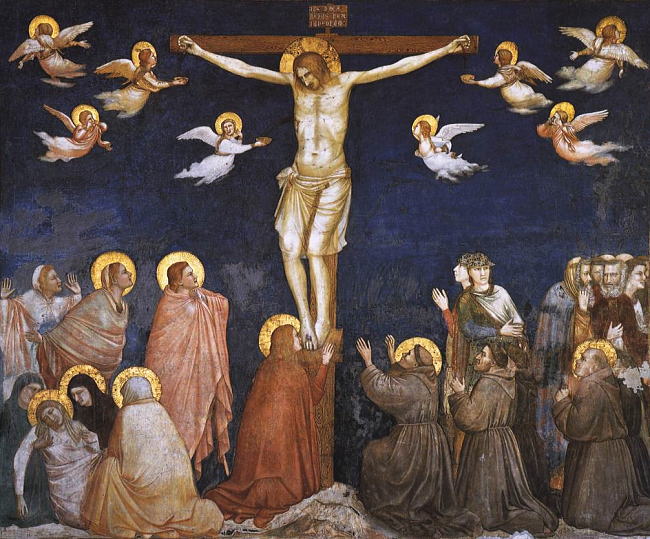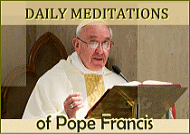Readings: Is 52:13—53:12; Ps 31:2, 6, 12-13, 15-16, 17, 25; Heb 4:14-16; 5:7-9; Jn 18:1—19:42
HIS DESTINY WAS THE CROSS
HIS PURPOSE WAS LOVE
HIS REASON WAS YOU
“It is finished’; and he bowed his head and handed over his spirit.”
On Good Friday, the entire Church fixes her gaze on the Cross at Calvary. Each member of the Church tries to understand at what cost Christ has won our redemption. In the solemn ceremonies of Good Friday, in the Adoration of the Cross, in the chanting of the ‘Reproaches’, in the reading of the Passion, and in receiving the pre-consecrated Host, we unite ourselves to our Savior, and we contemplate our own death to sin in the Death of our Lord.
The Church – stripped of its ornaments, the altar bare, and with the door of the empty tabernacle standing open – is as if in mourning. In the fourth century the Apostolic Constitutions described this day as a ‘day of mourning, not a day of festive joy,’ and this day was called the ‘Pasch (passage) of the Crucifixion.’
- The government of Polish Prime Minister Jaruzelski had ordered crucifixes removed from classroom walls, just as they had been banned in factories, hospitals, and other public institutions. Catholic bishops attacked the ban that had stirred waves of anger and resentment all across Poland. Ultimately the government relented, insisting that the law remain on the books, but agreeing not to press for removal of the crucifixes, particularly in the schoolrooms.But one zealous Communist school administrator in Garwolin decided that the law was the law. So one evening he had seven large crucifixes removed from lecture halls where they had hung since the school’s founding in the twenties. Days later, a group of parents entered the school and hung more crosses. The administrator promptly had these taken down as well.The next day two-thirds of the school’s six hundred students staged a sit-in. When heavily armed riot police arrived, the students were forced into the streets. Then they marched, crucifixes held high, to a nearby church where they were joined by twenty-five hundred other students from nearby schools for a morning of prayer in support of the protest. Soldiers surrounded the church. But the pictures from inside of students holding crosses high above their heads flashed around the world. So did the words of the priest who delivered the message to the weeping congregation that morning. “There is no Poland without a cross.” — Chuck Colson, Kingdoms in Conflict, pp. 202-3.
- I was brought up by pious Jewish parents in a Hungarian Roman Catholic village, where, as a boy, I saw again and again and was arrested by the sight of a crucifix and people kneeling and praying before it, and I observed at the head of the crucifix four mysterious letters I.N.R.I. I remember how often I asked myself what all this meant—the crucified figure as well as the four letters—and nobody among my own people would tell me. The riddle, and my perplexity about it, lasted until I grew up, then for the first time in my life a New Testament fell into my hands, the existence of which I knew nothing of until then. I shall never forget my surprise and sensation when reading for the first time, the story of Jesus and His crucifixion, as well as the meaning and origin of those four mysterious letters which had puzzled me so much during my boyhood. The scales fell from my eyes, and “Jesus, Nazarenus, Rex ludaeorum”—Jesus of Nazareth, King of the Jews — became from that moment my King and Redeemer, separating me for His sake from my own people, ready to live and die for Him. And my case prefigures what will happen one day to Christless Israel as a whole—they will acknowledge and crown Him, and live and die for Him. Yes, Jesus Christ is yet to be King of the Jews!—The Dawn
We need people of the cross, with the message of the cross, bearing the marks of the cross. — Vance Havner
***********************************
There are no crown-wearers in heaven who were not cross- bearers here below.
— Charles Haddon Spurgeon
***********************************
Jesus was crucified, not in a cathedral between two candles, but on a cross between two thieves. — George F. MacLeod
A crucifix or cross hangs somewhere in almost every Catholic home, in every Catholic school and institution. The crucifix or cross is the central and most widely known symbol of Christianity and has been for over two thousand years. In a world where little seems permanent, where things come and go easily, where passing fads are commonplace, where so much is considered relative, the fact that a symbol has endured for so long everywhere should convey something to everyone who sees it, even to those who do not believe in Christ or Christianity or religion.
The cross, or better, the crucifix — the difference being that the crucifix displays Jesus’ brutalized body – — has endured because it depicts and represents the turning point of humanity and life in this world has we have known it. The Lord Jesus Christ — the Word made Flesh, the King of Kings and the Lord of Lords, God Himself — was put to death by us, by those He came to save, the saddest admission we have to make. But, the most hopeful admission we have to make is that He died for us and in His death, He did save us. Nothing more important has ever happened in the history of the world than the moment of His death, which we remember in a dramatic way today, Good Friday, and every time we look at the crucifix. And we who believe, who have faith in the Lord Jesus Christ, also know that His death was not, is not the end of the story.
Think for a moment about the cross: two beams of common, simple wood. Originally, it had no other purpose than to be an instrument of death. What brings those beams together, what makes the cross a crucifix is not the intersection of wood upon wood, no. What brings those beams together and makes the cross a crucifix is the intersection of wood and flesh: a body stretched on a vertical wooden beam; arms outstretched on a horizontal wooden beam, a body with its furthermost extensions attached by nails. This instrument of death was reserved for criminals and those considered unworthy of human life and human breath.
The cross that we behold, the crucifix that is the central symbol of our faith, held the body of the One whose only crime was that He loved us without condition or reservation and that He was willing to show the depth of His love with the ultimate and absolute sacrifice. “Greater love than this no man has than that he lay down his life for his friends (John 15: 13).” This was the love of Jesus Christ, the Son of God, for us, His friends. It was He, this criminal who was considered unworthy of human life and breath and, so, put to death on a cross, it was He whose death made all human life worthy; whose sacrifice made every human breath holy. In Jesus Christ, God’s love was made real, visible, tangible.
God’s love makes no exceptions. As Jesus Christ walked to His crucifixion, He carried on His shoulders not only a cross but also the weight of us all. “It was our infirmities he bore, our sufferings he endured … he was pierced for our offenses, crushed for our sins … the Lord laid upon him the guilt of us all” (Isaiah 53: 4-6). My sisters and brothers, the crucifix is not a decoration or merely a symbol. The crucifix is the most powerful reminder of the greatest love the world has ever known: one wooden beam pointing from the earth to the sky, pointing our attention to God; another wooden beam pointing from east to west, pointing our attention to our fellow human beings. And what brings those two wooden beams, those two directions together, is a single body, His body, Jesus Christ, whose life of suffering and transforming love was a life and a love for all: a crucified love that has endured and will continue to endure. A love that turns the wood of a tree, the tree of defeat and death, into a tree of life and victory.
*********************************************
What Held Him to the Cross?
Not the nails, but His wondrous love for me,
Kept my Lord on the cross of Calvary,
Oh, what power could hold Him there—
All my sin and shame to bear?
Not the nails, but His wondrous love for me.
—Sunday School Times
*********************************************
Why is this day called “Good Friday”?
Good Friday is the most solemn day of the Christian year. It is the day our Savior died for us. It is the day we were redeemed from our sins by the voluntary death of God Himself at the hands of man.
It’s not for the reason you might think. Despite the fact that “good” is a common English word, tempting us to say the name is based on the fact that something very good (our redemption) happened on this day, that’s not where the name comes from.
The origin of the term Good is not clear. Some say it is from “God’s Friday” (Gottes Freitag); others maintain that it is from the German Gute Freitag, and not specially English.
It is also argued that the name is based on a Medieval use of the word good where it meant “holy.” Thus “Good Friday” would have come from “Holy Friday,” the same way we have Holy Thursday and Holy Saturday.
***********************************************
The Latin form of “Jesus of Nazareth, the King of the Jews” is
“Iesus Nazarenus Rex Iudaeorum”.
The first letters of this title provides us with INRI.
***********************************************
SEVEN LAST WORDS OF JESUS ON THE CROSS
The First Word – (Luke 23:34)
“Father, forgive them; for they know not what they do”.
The Second Word – (Luke 23:43)
“Amen, I say to thee, today thou shalt be with me in Paradise.”
The Third Word – (John 19:26-27)
“Woman, behold thy son… Behold thy mother”
The Fourth Word – (Mark 27:46)
“My God, my God, why hast thou forsaken me?”
The Fifth Word- (John 19:28)
“I thirst. “
The Sixth Word – (John 19:30)
“It is consummated.”
The Seventh Word – (Luke 23:46)
“Father, into thy hands I commend my spirit.”
Fr. Gaspar Fernandes, OFM Cap.


